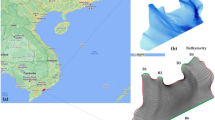Abstract
Sea level comprises a mean level, tidal elevation and a residual elevation. Knowledge of what causes maximum water levels is often key in coastal management. However, different methods to extract deviations in water level (residuals) from modelled and observed elevation can give different results. The Dee Estuary, northwest England is a macrotidal estuary that undergoes periodic stratification. It is used here to demonstrate methods to extract the residual water level in response to the following interactive processes: tidal, river-induced stratification and flow, meteorology and waves. Using modelling techniques, the interaction and contribution of different physical processes are investigated. Classical harmonic tidal analysis, model simulations and filtering techniques have been used to “de-tide” the total elevation for short-term (approximately month long) records. Each technique gives a different result highlighting the need to select the correct method for a required study. Analysis of the residual components demonstrates that all processes inducing residuals interact with the tide generating a semi-diurnal residual component. It is suggested that modelling methods enable the full effect of tidal interaction to remain in the residual, whilst harmonic tidal analysis (partly) modify and filtering methods (fully) remove this component of the residual. The analysis methods presented and their influences on the resultant residual are applicable to other study sites. However, when applied specifically to the mouth of the Dee Estuary, the external surge is found to be the main contributor to the total residual, whilst local wind and stratification effects are of secondary importance.





Similar content being viewed by others
References
Amin M (1982) On analysis and forecasting of surges on the west coast of Great Britain. Geophys J R Astron Soc 68(1):79–94
Bolaños R, Souza A (2010) Measured hydrodynamics and sediment transport processes in the Dee Estuary. Earth Syst Sci Data 2:157–165
Bolaños R, Brown JM, Souza A (2011) Three dimensional circulation modeling in the Dee Estuary. J Coast Res SI 64:1457–1461
Bolaños R, Brown JM, Amoudry LO, Souza A (Submitted). Tides, river and wind influence on the circulation in a macrotidal estuary. Submitted to Journal of Physical Oceanography
Brown JM, Souza AJ, Wolf J (2010) An 11-year validation of wave-surge modelling in the Irish Sea, using a nested POLCOMS–WAM modelling system. Ocean Modelling 33(1–2):118–128
Cartwright DE, Amin M (1986) The variances of tidal harmonics. Deut Hydrogr Z 39(6):235–253
Castanado S, Mendez FJ, Medina R, Abascal AJ (2007) Long-term tidal level distribution using a wave-by-wave approach. Adv Water Resour 30(11):2271–2282
De Vries H, Breton M, De Mulder T, Krestenitis Y, Ozer J, Proctor R, Ruddick K, Salomon JC, Voorrips A (1995) A comparison of 2D storm surge models applied to three shallow European seas. Environ Softw 10(1):23–42
Emery WJ, Thomson RE (2001) Data analysis methods in physical oceanography, 2nd edn. Elsevier, Amsterdam, p 638
Godin G (1972) The analysis of tides, Liverpool University Press, 264 pp.
Goring DG, Stephens SA, Bell RG, Rearson CP (2011) Estimation of extreme sea levels in a tide-dominated environment using short data records. J Waterw Port Coast Ocean Eng 137(3):150–159
Hamming RW (1983) Digital filters, 2nd edn. Prentice-Hall, Englewood Cliffs, 257 pp
Holt JT, James ID (2001) An s coordinate density evolving model of the northwest European continental shelf: 1, model description and density structure. J Geophys Res 106(C7):14,015–14,034
Horsburgh KJ, Wilson C (2007) Tide–surge interaction and its role in the distribution of surge residuals in the North Sea. J Geophys Res 112(C08003), 13 pp, doi:10.1029/2006JC004033
Jay DA, Flinchem EP (1999) A comparison of methods for analysis of tidal records containing multi-scale non-tidal background energy. Cont Shelf Res 19(13):1695–1732
Jevrejeva S, Moore JC, Grinsted A, Woodworth PL (2008) Recent global sea level acceleration started over 200 years ago? Geophys Res Lett 35(L08715):4 pp.
Komen GJ, Cavaleri L, Donelan M, Hasselmann K, Hasselmann S, Janssen PAEM (1994) Dynamics and modelling of ocean waves. Cambridge University Press, Cambridge, 532 pp
Leffler KE, Jay DA (2009) Enhancing tidal harmonic analysis: robust (hybrid L1 /L2) solutions. Cont Shelf Res 29(1):78–88
Mastenbroek C, Burgers G, Janssen PAEM (1993) The dynamical coupling of a wave model and a storm surge model through the atmospheric boundary layer. J Phys Oceanogr 23(8):1856–1866
Monbaliu J, Padilla-Hernández R, Hargreaves JC, Carretero-Albiach JC, Luo W, Sclavo M, Günther H (2000) The spectral wave model WAM adapted for applications with high spatial resolution. Coastal Eng 41(1–3):41–62
Munk WH, Zetler B, Groves GW (1965) Tidal cusps. Geophys J R Astron Soc 10(2):211–219
Palmer MR (2010) The modification of current ellipses by stratification in Liverpool Bay ROFI. Ocean Dyn 60(2):219–226
Prandle D (1975) Storm surges in the southern North Sea and River Themes. Proc R Soc London A 344(1639):509–539
Pugh DT (1987) Tides, surges and mean sea level. Wiley, Chichester, 472 pp
Pugh DT, Vassie JM (1976) Tide and surge propagation off-shore in the Dowsing region of the North Sea. Dtsch Hydrogra Z 29(5):163–213
Pye K (1996) Evolution of the shoreline of the Dee Estuary, United Kingdom. In: Nordstrom KF, Roman CT (eds) Estuarine shores: evolution, environments and human alterations. Wiley, Hoboken, pp 14–37
Rossiter JR (1959) A method for extracting storm surges from tidal records. Dtsch Hydrogr Z 12(3):117–127
Umlauf L, Burchard H (2005) Second-order turbulence closure models for geophysical boundary layers. A review of recent work. Cont Shelf Res 25(7–8):795–827
Acknowledgments
This research has been carried out as part of Oceans 2025, the FORMOST project (NERC grant NE/E015026/1) and the Field_AC project (EC grant 24284). Jane Williams (NOC) is thanked for providing the operational surge model output and meteorological (wind and pressure) data, whilst Clare O'Neill is thanked for providing the offshore temperature and salinity fields to the Irish Sea and supplementing the meteorological forcing with air temperature, humidity, and cloud cover to enable full atmospheric forcing.
Author information
Authors and Affiliations
Corresponding author
Additional information
Responsible Editor: Richard Signell
Rights and permissions
About this article
Cite this article
Brown, J.M., Bolaños, R., Howarth, M.J. et al. Extracting sea level residual in tidally dominated estuarine environments. Ocean Dynamics 62, 969–982 (2012). https://doi.org/10.1007/s10236-012-0543-7
Received:
Accepted:
Published:
Issue Date:
DOI: https://doi.org/10.1007/s10236-012-0543-7



